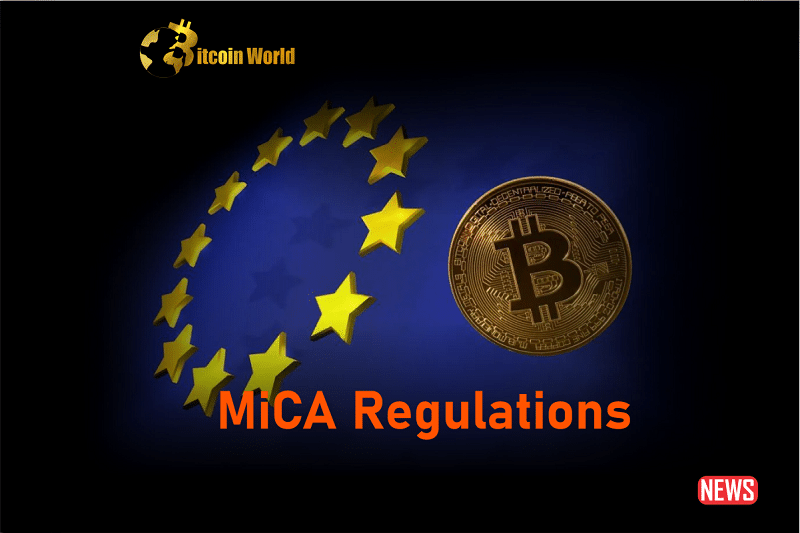The European Union has taken a bold step by introducing the Markets in Crypto-Assets (MiCA) regulation, becoming the first major jurisdiction to establish a comprehensive legal framework for the crypto industry. The aim is clear: provide legal certainty for both businesses and investors across the EU through standardized guidelines. But is this a leap forward, or could it inadvertently clip the wings of crypto innovation?
MiCA: A Double-Edged Sword for the Crypto Space?
While the intention behind MiCA is commendable – creating a safer and more regulated environment – there are concerns that its one-size-fits-all approach, particularly towards Decentralized Finance (DeFi), might present some significant hurdles. Let’s delve into some of these potential challenges:
- Innovation Under Pressure: Could MiCA’s broad strokes hinder the unique nature of decentralized networks? Imagine trying to fit a square peg into a round hole – that’s the worry some have about applying standardized rules to the diverse landscape of DeFi.
- Rising Compliance Costs: For Decentralized Exchanges (DEXs) and DeFi platforms, adhering to MiCA could mean significant increases in compliance expenses. This might limit their capacity to experiment and introduce novel products and services.
- Privacy Concerns on the Horizon: The regulation mandates the collection and storage of substantial personal data, raising red flags about potential privacy breaches and vulnerabilities to cyberattacks.
Learning from Traditional Finance: A Cautionary Tale?
History offers valuable lessons. Consider the Dodd-Frank Act and similar regulations in traditional finance. While designed to enhance stability, they’ve faced criticism for potentially stifling innovation. For instance, the increased regulatory burden made it tougher for smaller banks to compete, leading to consolidation within the banking sector. Could MiCA have a similar effect on the crypto world?
The Dodd-Frank Example:
| Aspect | Impact of Dodd-Frank | Potential MiCA Parallel |
|---|---|---|
| Compliance Costs | Increased significantly, especially for smaller institutions. | Could create barriers for smaller DeFi projects and DEXs. |
| Market Centralization | Contributed to the consolidation of the banking industry. | Might lead to a less diverse and more centralized DeFi landscape. |
| Innovation | Some argue it slowed down innovation due to regulatory overhead. | Potential to hinder the development of new DeFi solutions. |
Just as Dodd-Frank presented challenges for smaller players in traditional finance, MiCA’s requirements could make it difficult for nascent DeFi projects to enter the market and thrive. This could inadvertently go against the core ethos of DeFi – a decentralized, open, and permissionless financial system.
The Price of Compliance: A Barrier to Entry?
The implementation of MiCA is expected to increase compliance costs for crypto exchanges and DeFi platforms. Think of it like this: just as traditional financial institutions face significant expenses to meet regulatory requirements, crypto businesses will need to invest in systems, personnel, and legal expertise to adhere to MiCA. This is crucial for consumer protection, anti-money laundering efforts, and maintaining market integrity, but it comes at a cost.
Compliance Costs: A Closer Look
- Traditional Finance Experience: Following the 2008 financial crisis, banks and insurance companies saw a surge in compliance costs due to regulations like Basel III. This involved significant investment in staffing, technology, and legal counsel.
- MiCA’s Potential Impact: Similarly, MiCA could lead to higher operational costs for crypto businesses, potentially acting as a barrier for new entrants. Smaller startups might struggle to compete with larger, more established players who have the resources to manage these expenses.
Privacy Under Scrutiny: Are User Data at Risk?
A key aspect of MiCA is the requirement for crypto-asset service providers to collect and store a substantial amount of personal data. This includes user identification, transaction history, and other sensitive information. While intended to combat illicit activities, this data collection raises valid concerns about privacy violations and the potential for data breaches.
Echoes of the Past: Privacy Concerns in Traditional Finance
We’ve seen similar debates around privacy with traditional financial legislation like the US Bank Secrecy Act (BSA) and the EU’s General Data Protection Regulation (GDPR). While GDPR aims to protect user data, some argue its stringent requirements can be burdensome. The BSA, with its reporting obligations, has also faced criticism for potentially exposing client data.
MiCA and Privacy: Potential Pitfalls
- Increased Vulnerability: Centralized storage of vast amounts of personal data can make crypto platforms attractive targets for hackers.
- Disadvantage for Smaller Players: The cost of implementing robust data security measures might disproportionately affect smaller businesses.
- Innovation Chill: Fear of data breaches and the complexities of compliance could stifle innovation within the crypto space.
Finding the Balance: Collaboration is Key
Ultimately, the success of MiCA in fostering a healthy crypto ecosystem hinges on finding a delicate balance. Regulation is necessary to protect consumers and ensure market integrity, but it shouldn’t come at the expense of innovation and the fundamental principles of decentralization. Open dialogue and collaboration between the crypto industry and regulators are crucial to navigate these challenges effectively.
Authorities need to consider how to foster innovation while ensuring adequate protection. Perhaps a tiered approach to regulation, acknowledging the diverse nature of crypto projects, could be a solution. Focusing on principles-based regulation rather than overly prescriptive rules might also allow for more flexibility and adaptability in this rapidly evolving sector.
Conclusion: Navigating the MiCA Maze
The EU’s MiCA regulations represent a significant step towards bringing clarity to the crypto landscape. However, as with any sweeping regulatory framework, there are potential challenges to navigate. Concerns around stifled innovation, increased compliance costs, and privacy risks need careful consideration. The path forward requires a collaborative approach, ensuring that regulation empowers rather than hinders the growth and potential of the crypto industry. The future of crypto in Europe may well depend on striking this delicate balance.
Disclaimer: The information provided is not trading advice, Bitcoinworld.co.in holds no liability for any investments made based on the information provided on this page. We strongly recommend independent research and/or consultation with a qualified professional before making any investment decisions.


